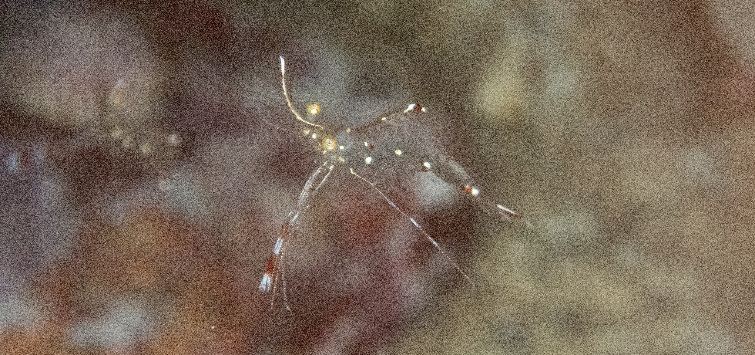Candy Cane Crustaceans: Keeping Coral Banded Shrimp
Marijke Puts
Did Christmas come early this year? Nope, that’s just the candy-cane-striped Stenopus hispidus, more commonly referred to as the coral banded shrimp. A favorite among aquarists thanks to its relatively large size and bright colors, this species can be found on every list of popular aquarium shrimp. This is despite the fact that it’s not actually a shrimp at all.
The genus Stenopus currently contains 11 recognized species, with new additions described regularly. Scientists don’t consider Stenopus real shrimp but merely “shrimp-like”; they make up a separate branch of the Decapoda family tree, which includes all species of shrimp but also similar crustaceans like lobsters and crabs. Although the genus is closely related to true shrimp, it belongs to a distinct family known as the Stenopodidae, the boxer shrimps.
Members of the genus Stenopus, including today’s subject, share two characteristics that make them easy to identify. First, they’re highly colorful, usually red and white, but there are exceptions, like the striking, purple-faced, blue coral banded shrimp (S. tenuirostris) and the orange-hued golden coral shrimp (S. spinosus). Second they sport extra-long arms—their third pereiopods (walking limbs) are much bigger than those of similar crustaceans and come with impressive pincers.
The latest additions to the genus, described in 2009 (S. goyi) and 2023 (S. sayaensis), both hail from deep waters, but most Stenopus shrimp kept in the aquarium are naturally found in shallow reef environments. The coral banded shrimp, in particular, boasts a circumtropical distribution. This means it can be spotted while diving or snorkeling in warm waters pretty much worldwide.
I’ve come across S. hispidus in the Andaman Sea and Caribbean Sea myself, but they’re also a frequent sight in the Red Sea and other popular underwater travel destinations. If you’re having trouble locating them, think upside-down—I’ve found that peeking under rock and coral ledges using a flashlight is the easiest way to find coral banded shrimp. It’s always a pleasure to meet one of our aquarium favorites in the wild!
Should I Get a Coral Banded Shrimp?
Coral banded shrimp are known for being somewhat “spicier” than many other common aquarium shrimp species, like the peaceful cleaner shrimp. They’re a little unpredictable, with some individuals causing no problems whatsoever and others that end up creating mayhem. I think their beautiful colors and fascinating behavior make them more than worth it, but it’s best not to introduce them into tanks with more fragile livestock.
Most, though not all, aquarists report coral banded shrimp leaving their fish alone. How they treat other shrimp, however, is a different story. These critters tend to get extremely attached to their territory, rarely moving around and viciously defending what they consider their spot from anything that looks too much like a competitor.
Are Banded Coral Shrimp Reef Safe?
Things are similar when it comes to corals: Most coral banded shrimp don’t pick at them unless they’re starving, but there are exceptions. Additionally, they’re prone to walking all over corals and anemones while foraging, so I can’t advertise coral banded shrimp as 100-percent reef safe.
Do Coral Banded Shrimp Get Along with Each Other?
Coral banded shrimp are extremely intolerant of members of the same genus, meaning other coral banded shrimps. In the presence of each other, they go from being peppermint-level spicy to jalapeño spicy! The exception is with mated pairs.
Like many other decapods, coral banded shrimp form long-lasting, monogamous partnerships. Biologists have found that they have the ability to recognize their mate, which is rather unique among invertebrates and likely works through chemical cues, such as from scent and taste. Finding a compatible pair can be difficult, but it’s well worth it to see them interacting in the aquarium.
If you’re lucky and get a male and female, they’ll often coexist, but not even all pairs are compatible! In the most common coral banded shrimp, S. hispidus, females can be spotted by the blue-green ovaries under the tail and the presence of blue spots on the large claws. Shrimp lacking these may be males or immature females.
Be prepared to separate shrimp immediately if aggression occurs. They’ll often rip each other’s claws off, but they do grow back. But at the end of the day, do realize that a single coral banded shrimp will be perfectly happy. Due to their size, these shrimp aren’t a good choice for a nano or pico aquarium. They’ll reach about 3 inches (7.5 cm) with a huge “wingspan” due to those big arms. A larger tank with plenty of overhangs and shelter is called for.
Aquarium Setup & Tankmates
Setting up a welcoming environment for a pair of coral banded shrimp isn’t too challenging. As I’ve mentioned, these nocturnal shrimp tend to claim territory and not move around very much, especially when the tank lights are on. Their favorite position in the wild is upside-down, clinging to ledges and crevices, so try to position some (live) rock in a way that allows your shrimp to do the same in your aquarium.
Although coral banded shrimp are suitable for beginning aquarists, it’s important to stay on top of maintenance and weekly water changes, as shrimp and related invertebrates in general don’t respond well to low water quality.
General reef parameters should work fine. As always, be sure to slowly acclimate your shrimp when first introducing them into the tank; sudden swings in water composition can cause potentially deadly shock.
As for tankmates, we’ve already concluded that other shrimp species are out. I’d also avoid small, slow-moving invertebrates like hermit crabs or snails—as should be clear by now, a hungry coral banded shrimp can be somewhat of a loose cannon.
Fish are fine, since they’re usually too quick for these shrimp to catch even if they wanted to. Because they’re a cleaner species, the shrimp themselves should be safe even from larger fish, provided there’s enough room to go around and no one is left hungry for extended periods of time.
Diet in the Wild and the Aquarium
Coral banded shrimp are considered cleaners, a loose definition for invertebrates and fish that feed on parasites and skin bits they pick off other reef inhabitants. Indeed, these shrimp advertise their services by “dancing” to get potential clients’ attention.
As a 2005 article in the journal Current Biology describes it, “The cleaner shrimp Stenopus hispidus...perform vigorous whipping of their antennae and lateral body swaying while standing in a conspicuous location when a client fish is nearby.”
Although wild coral banded shrimp have no qualms about interacting with even the most dangerous reef fish—I’ve seen them perform dentistry on a moray eel’s needle-like teeth—it’s unfortunately not a behavior you’ll see very often in the aquarium. They only seem to do it when they’re very hungry, which would be unusual in an environment where they receive food on a regular basis.
Coral banded shrimp can make a useful addition to your aquarium cleaning crew. They’re omnivorous and will pick at pretty much anything they can find, from leftover foods to algae and general detritus.
They’re also frequently sold as a solution to bristleworms, common aquarium hitchhikers considered by most fishkeepers to be undesirable in their tanks. The shrimp just love snacking on these annoying worms, some of which can irritate your skin with their toxic bristles if you accidentally brush past them.
Feeding your tank up to four times a week should be enough to keep your coral banded shrimp happy and healthy. If you see them picking at corals or trying to clean your fish, you may have to target feed them, as it’s possible they’re not getting enough and are hungry.
Reproduction

If you’ve ever tried your hand at breeding marine shrimp, you’ll know it’s not an easy task. They start out their lives as tiny larvae that pass through multiple developmental stages before metamorphosing into actual shrimp. Raising the fragile larvae is incredibly difficult, and a lot of aquarists don’t consider it worth the effort.
Coral banded shrimp are particularly challenging to raise. Unfortunately, it’s not something that’s done on a large commercial scale yet; no commercial aquaculture facility has managed to develop a way to easily do it, and hobbyists don’t seem to fare much better. As a result, most of the Stenopus shrimp you’ll find at your local aquarium store are wild caught. If you’ve got some experience breeding shrimp and can set up a dedicated rearing tank, you can give it a shot, but don’t be surprised at the super-high larval mortality rate.
Like most other decapods, coral banded shrimp mate shortly after the female molts, which happens once or twice a month for adult specimens. The smaller male will perform a little dance and wiggle his antennae for the female, after which the two pair up. (Yes, shrimp are rather into dancing in general.)
Once the female has received the sperm sack, she’ll use it to fertilize a batch of eggs contained in her ovaries, after which she moves the eggs to her pleopods. The larvae hatch after around 16 days.
The larvae are so tiny and helpless, though, that they’re usually immediately sucked into the aquarium filter or eaten by the shrimps’ tankmates. The chances of the babies making it to adulthood are pretty slim. It just takes ages for them to metamorphose—up to 210 days. If your shrimp do breed, think of it as a bounty of free live food for your aquarium residents.
More Than Meets the Eye
As always with our favorite aquarium inhabitants, there’s more to the decorative coral banded shrimp than meets the eye. This fascinating crustacean, found in warm waters around the world and wildly popular in the aquarium trade, may be more territorial than most of its cleaner shrimp cousins, but it’s also endlessly interesting to watch as it goes about its shrimpy business.
Whether you’re interested in keeping coral banded shrimp for their vibrant colors or intriguing behaviors, or because you’d like them to assist with janitorial duties in your tank, you’re guaranteed to enjoy seeing their long antennae peek out from your home reef when you turn on the tank lights each morning.




